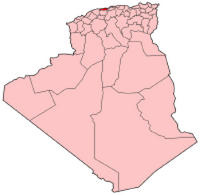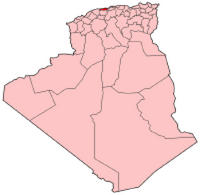You are in: Africa -> Algeria -> Tipasa, and traditional search or Image Gallery will yield results of this site only
Tipasa
| Site number: | 193 |
|
| Type of site: | Cultural | |
| Date: | 100 AD | |
| Date of Inscription: | 1982 | |
| Location: | Africa, Algeria, Commune and Wilaya (province) of Tipasa | |
Up to 75 images are shown here. Click on each for more details or on Image Gallery for more images.
Six official UN languages:
Arabic,
Chinese,
English,
French,
Russian,
Spanish
Other languages: Dutch, Finnish, German, Italian, Lithuanian, Norwegian-bokmål, Polish, Portuguese, Swedish
Other languages: Dutch, Finnish, German, Italian, Lithuanian, Norwegian-bokmål, Polish, Portuguese, Swedish
| Description: | In the Roman conquest of the Mauritanian kingdoms, Tipasa (once an ancient Punic trading post on the Mediterranean shore) was converted into a strategic base. Accompanied with endemic monuments like Kbor er Roumia, and the great Mauritanian royal mausoleum, this site includes a rare grouping of Phoenician, Roman, paleochristian as well as Byzantine ruins. --WHMNet paraphrase from the description at WHC Site, where additional information is available. | |
| Tipaza (formerly Tefessedt, Chenoua: Bazar) not to be confused with Tébessa. is a town on the coast of Algeria, capital of the Tipasa wilaya. Tipaza was founded by the Phoenicians. It was made a Roman military colony by the emperor Claudius, and afterwards became a municipium. The Roman city was built on three small hills which overlooked the sea. Of the houses, most of which stood on the central hill, no traces remain; but there are ruins of three churches — the Great Basilica and the Basilica Alexander on the western hill, and the Basilica of St Salsa on the eastern hill, two cemeteries, the baths, theatre, amphitheatre and nymphaeum. The line of the ramparts can be distinctly traced and at the foot of the eastern hill the remains of the ancient harbour. The basilicas are surrounded by cemeteries, which are full of coffins, all of stone and covered with mosaics. The basilica of St. Salsa, which has been excavated by Stéphane Gsell, consists of a nave and two aisles, and still contains a mosaic. The Great Basilica served for centuries as a quarry, but it is still possible to make out the plan of the building, which was divided into seven aisles. Under the foundations of the church are tombs hewn out of the solid rock. Of these one is circular, with a diameter of 18 m and space for 24 coffins. Commercially it was of considerable importance, but it was not distinguished in art or learning. Christianity was introduced early, and in the third century Tipaza was a bishop's see. Most of the inhabitants continued as non-Christians until, according to the legend, Salsa, a Christian maiden, threw the head of their serpent idol into the sea, whereupon the enraged populace stoned her to death. The body, miraculously recovered from the sea, was buried, on the hill above the harbour, in a small chapel which gave place subsequently to the stately basilica. Salsa's martyrdom took place in the 4th century. In 484 the Vandal king Huneric (477 484) sent an Arian bishop to Tipaza; whereupon a large number of the inhabitants fled to Spain, while many of the remainder were cruelly persecuted. After this time the city disappears from history; and, whether or not its ruin was caused by the Arabs, they seem to have made no settlement there. --Wikipedia. Text is available under the Creative Commons Attribution-ShareAlike License. | ||
| Source: | http://whc.unesco.org/en/list/193 | |
| Reference: | 1. UNESCO World Heritage Center, Site Page. | |

























